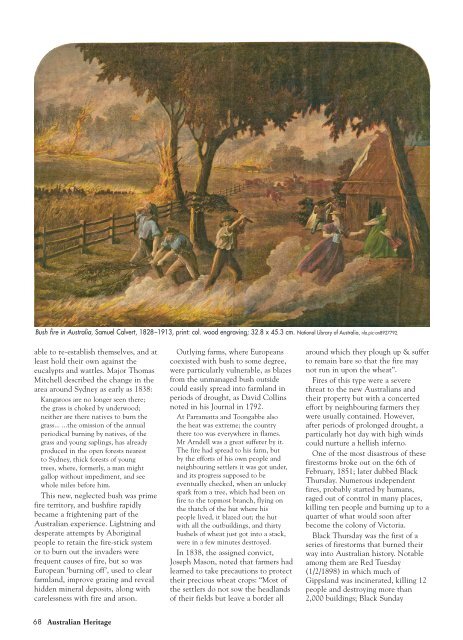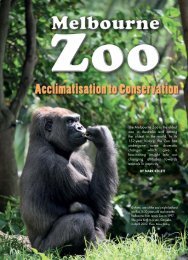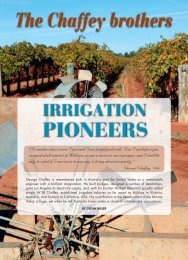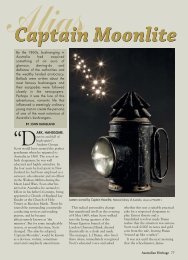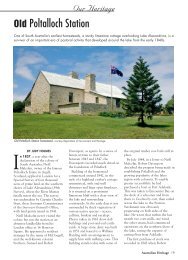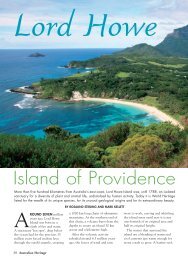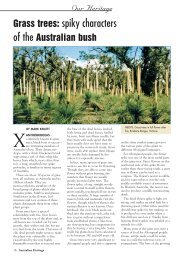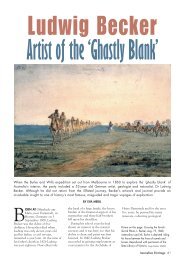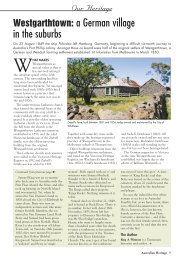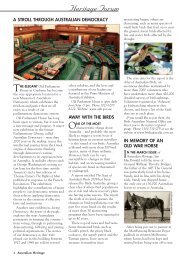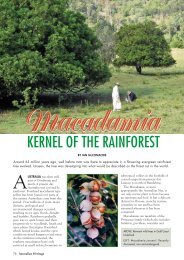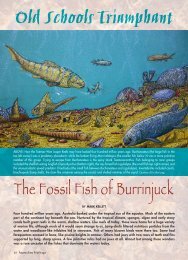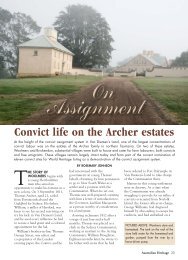Heritage 0308_Bushfire.pdf - Australian Heritage Magazine
Heritage 0308_Bushfire.pdf - Australian Heritage Magazine
Heritage 0308_Bushfire.pdf - Australian Heritage Magazine
Create successful ePaper yourself
Turn your PDF publications into a flip-book with our unique Google optimized e-Paper software.
Bush fire in Australia, Samuel Calvert, 1828–1913, print: col. wood engraving; 32.8 x 45.3 cm. National Library of Australia, nla.pic-an8927792.<br />
able to re-establish themselves, and at<br />
least hold their own against the<br />
eucalypts and wattles. Major Thomas<br />
Mitchell described the change in the<br />
area around Sydney as early as 1838:<br />
Kangaroos are no longer seen there;<br />
the grass is choked by underwood;<br />
neither are there natives to burn the<br />
grass... ...the omission of the annual<br />
periodical burning by natives, of the<br />
grass and young saplings, has already<br />
produced in the open forests nearest<br />
to Sydney, thick forests of young<br />
trees, where, formerly, a man might<br />
gallop without impediment, and see<br />
whole miles before him.<br />
This new, neglected bush was prime<br />
fire territory, and bushfire rapidly<br />
became a frightening part of the<br />
<strong>Australian</strong> experience. Lightning and<br />
desperate attempts by Aboriginal<br />
people to retain the fire-stick system<br />
or to burn out the invaders were<br />
frequent causes of fire, but so was<br />
European ‘burning off’, used to clear<br />
farmland, improve grazing and reveal<br />
hidden mineral deposits, along with<br />
carelessness with fire and arson.<br />
Outlying farms, where Europeans<br />
coexisted with bush to some degree,<br />
were particularly vulnerable, as blazes<br />
from the unmanaged bush outside<br />
could easily spread into farmland in<br />
periods of drought, as David Collins<br />
noted in his Journal in 1792.<br />
At Parramatta and Toongabbe also<br />
the heat was extreme; the country<br />
there too was everywhere in flames.<br />
Mr Arndell was a great sufferer by it.<br />
The fire had spread to his farm, but<br />
by the efforts of his own people and<br />
neighbouring settlers it was got under,<br />
and its progress supposed to be<br />
eventually checked, when an unlucky<br />
spark from a tree, which had been on<br />
fire to the topmost branch, flying on<br />
the thatch of the hut where his<br />
people lived, it blazed out; the hut<br />
with all the outbuildings, and thirty<br />
bushels of wheat just got into a stack,<br />
were in a few minutes destroyed.<br />
In 1838, the assigned convict,<br />
Joseph Mason, noted that farmers had<br />
learned to take precautions to protect<br />
their precious wheat crops: “Most of<br />
the settlers do not sow the headlands<br />
of their fields but leave a border all<br />
around which they plough up & suffer<br />
to remain bare so that the fire may<br />
not run in upon the wheat”.<br />
Fires of this type were a severe<br />
threat to the new <strong>Australian</strong>s and<br />
their property but with a concerted<br />
effort by neighbouring farmers they<br />
were usually contained. However,<br />
after periods of prolonged drought, a<br />
particularly hot day with high winds<br />
could nurture a hellish inferno.<br />
One of the most disastrous of these<br />
firestorms broke out on the 6th of<br />
February, 1851; later dubbed Black<br />
Thursday. Numerous independent<br />
fires, probably started by humans,<br />
raged out of control in many places,<br />
killing ten people and burning up to a<br />
quarter of what would soon after<br />
become the colony of Victoria.<br />
Black Thursday was the first of a<br />
series of firestorms that burned their<br />
way into <strong>Australian</strong> history. Notable<br />
among them are Red Tuesday<br />
(1/2/1898) in which much of<br />
Gippsland was incinerated, killing 12<br />
people and destroying more than<br />
2,000 buildings; Black Sunday<br />
68 <strong>Australian</strong> <strong>Heritage</strong>


